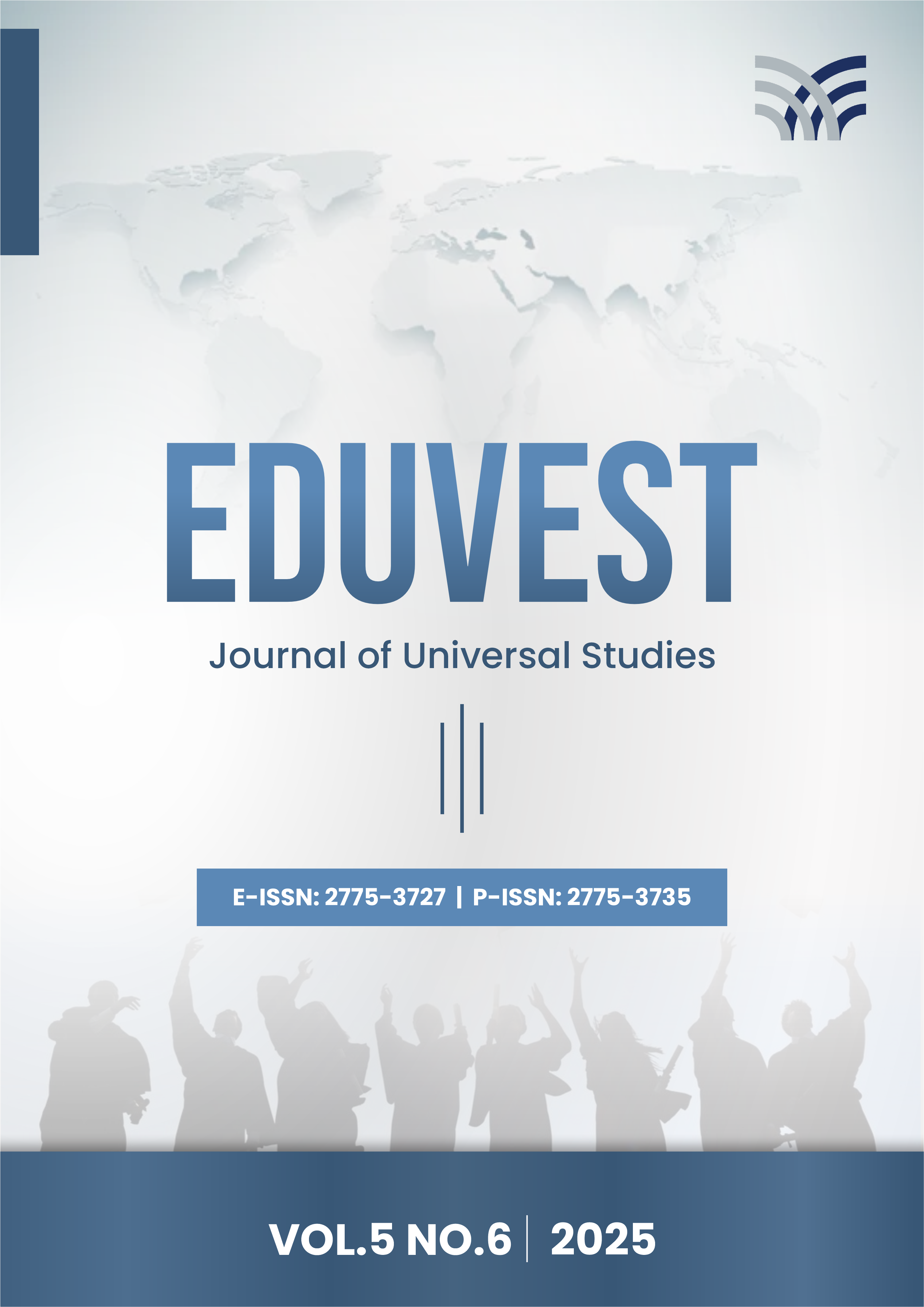Analysis of Wharf Strengthening Due to Dredging
DOI:
https://doi.org/10.59188/eduvest.v5i6.50862Keywords:
Dredging, Structural Reinforcement, Safety EvaluationAbstract
This study investigates the structural implications of dredging activities on steel piles and associated railway infrastructure. Specifically, the dredging process, which extended to a depth of 12 meters, effectively reduced the embedded length of the existing steel piles to 8 meters, thereby compromising their load-bearing capacity. Structural modeling and analysis revealed that the reduced pile embedment may lead to insufficient support under operational loads, raising concerns about potential failure and non-compliance with safety standards. As a result, reinforcement measures were implemented, including strengthening the pile heads and installing additional steel piles around the existing foundation. The analysis also assessed the structural performance of key railway components, particularly beams LB1 and LB2, which were found to adequately support the operational QCC load. However, further investigation is recommended for other structural elements to ensure overall system integrity. To maintain safety and performance standards, the study highlights the necessity of re-verifying soil properties post-dredging, performing supplementary structural analyses where required, and strictly adhering to safe operational protocols during railway use. Additionally, a thorough review of beam and plate design specifications is advised to confirm compliance with current structural codes. These findings underscore the importance of integrating geotechnical and structural evaluations in infrastructure projects involving dredging to mitigate safety risks and support sustainable infrastructure management.
References
Anisadila, C. R., Widhiarto, H., & Fatmawati, L. E. (2023). Replanning of pier structure reinforcement using pile foundations with diameter variations. Journal of Rab Construction Research, 8(1), 108–115. http://jurnal.univrab.ac.id/index.php/racic
ASTM International. (n.d.). ASTM D5882: Standard Test Method for the Determination of the Shear Strength of Soil Using the Direct Shear Test.
ASTM International. (2018). ASTM A252-10 (2018): Standard Specification for Welded and Seamless Steel Pipe Piles. https://doi.org/10.1520/A0252-10R18
Bandari, A., & Sadhukhan, S. (2021). Determinants of per capita water supply in Indian cities with low surface water availability. Cleaner Environmental Systems, 3. https://doi.org/10.1016/j.cesys.2021.100062
Chang, Y. L. (1959). Discussion on lateral piles loaded tests. Feagin Trans, ASCE, 1937, 272–278.
Chen, K., Lin, Y., Liu, J., He, Z., & Jia, L. (2024). Combined effects of massive reclamation and dredging on the variations in hydrodynamic and sediment transport in Lingdingyang Estuary, China. Frontiers of Earth Science, 18(1). https://doi.org/10.1007/s11707-022-1050-x
Czuba, J. A., David, S. R., Edmonds, D. A., & Ward, A. S. (2019). Dynamics of surface-water connectivity in a low-gradient meandering river floodplain. Water Resources Research, 55(3). https://doi.org/10.1029/2018WR023527
Forte, R., & Botelho, A. (2021). Debt–performance relationship and firms’ international trade activities. Managerial Finance, 47(4). https://doi.org/10.1108/MF-04-2020-0162
Masagala, A. A., Bhaskara, A., & Setiawan, D. (2021). Study on the evaluation of the strength of the existing pier structure of Tanjung Priok Port (Case Study: PT. Walie Jaya). Yogyakarta University of Technology.
Mundaca, G., Strand, J., & Young, I. R. (2021). Carbon pricing of international transport fuels: Impacts on carbon emissions and trade activity. Journal of Environmental Economics and Management, 110. https://doi.org/10.1016/j.jeem.2021.102517
Nilasari, N. V. A., & Kamaludin. (2016). Evaluation of the upper structure of the 1,000 DWT pier against various earthquake zones based on the guidelines for port planning procedures in 2015. Reka Racana-Online Journal of the National Institute of Technology, 2(3), 158–169.
Nurrachman, A. D., & Marjanah, I. D. (2023). Korelasi dampak aktivitas perdagangan internasional terhadap kerusakan lingkungan. PLEDOI (Jurnal Hukum Dan Keadilan), 2(2). https://doi.org/10.56721/pledoi.v2i2.187
Pittiglio, R. (2023). Counterfeiting and firm survival. Do international trade activities matter? International Business Review, 32(5). https://doi.org/10.1016/j.ibusrev.2023.102145
Putri, D. F., & Yuliani, Y. (2023). Implikasi etika bisnis dalam perdagangan internasional: Tinjauan terhadap kegiatan ekspor dan impor. Jurnal Ilmiah Manajemen, Bisnis Dan Kewirausahaan, 3(2). https://doi.org/10.55606/jurimbik.v3i2.457
Sandirasegaran, K., & Manap, N. (2016). Impacts of dredging and reclamation projects. Jurnal Teknologi, 78(7–3). https://doi.org/10.11113/jt.v78.9506
Sitorus, R., Widyastuti, D. I., & Fuddoly. (2023). Planning for repair and reinforcement of the north side of the construction pier for a 6,000 DWT general cargo ship at the PT Pupuk Kaltim Tersus, Bontang. ITS Engineering Journal, 12(1), E46–E53.
Ventura, D., Grosso, L., Pensa, D., Casoli, E., Mancini, G., Valente, T., Scardi, M., & Rakaj, A. (2023). Coastal benthic habitat mapping and monitoring by integrating aerial and water surface low-cost drones. Frontiers in Marine Science, 9. https://doi.org/10.3389/fmars.2022.1096594
Downloads
Published
How to Cite
Issue
Section
License
Copyright (c) 2025 Sumargo, Erwin Iriyanto Siagian

This work is licensed under a Creative Commons Attribution-ShareAlike 4.0 International License.











